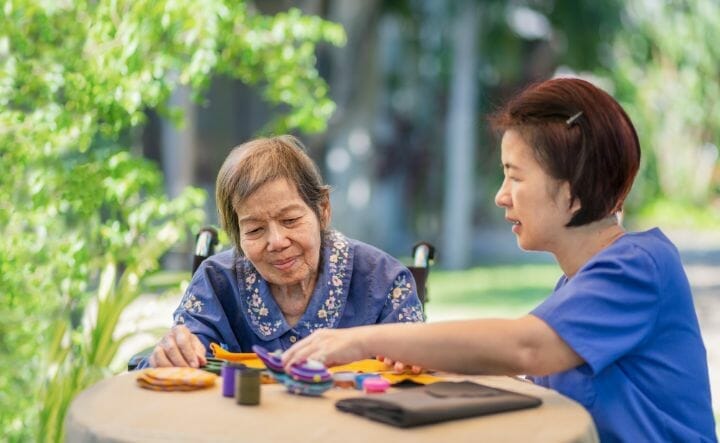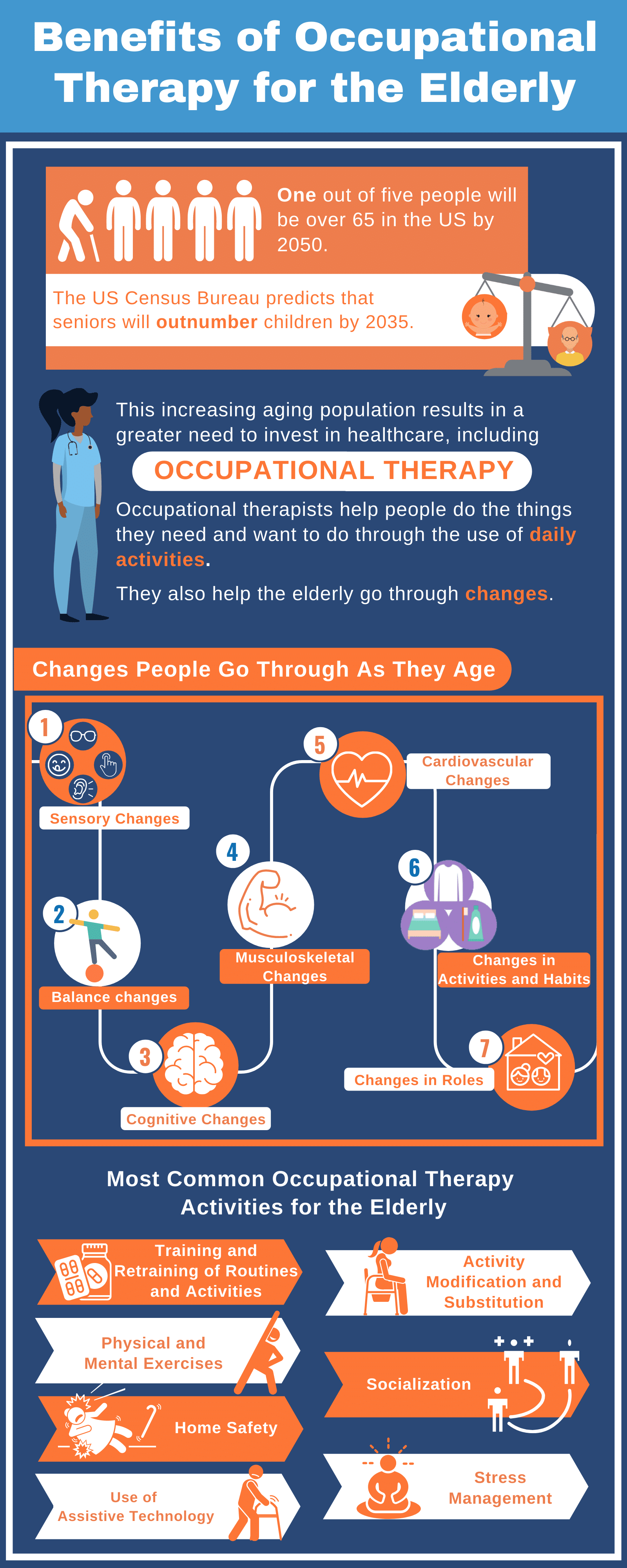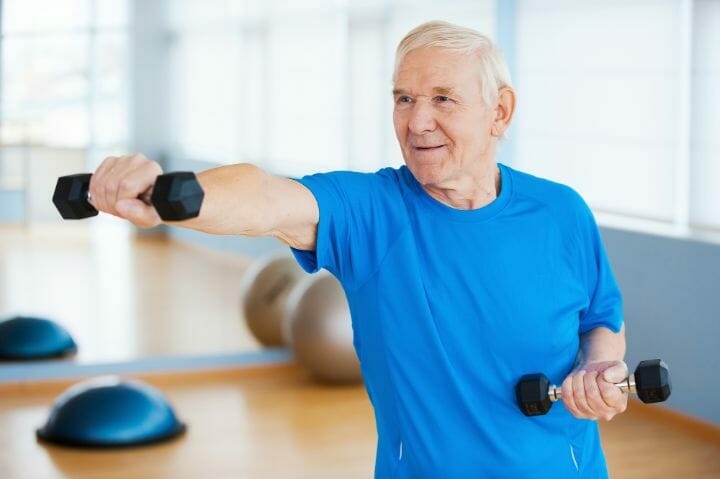The United Nations predicts that one in five Americans will be over 651 by 2050. With the aging of Baby Boomers – the largest cohort of the population in North America, more and more people need support to be able to perform their everyday tasks.
Some of the benefits of Occupational Therapy for the elderly include: learning or relearning of routines and daily activities, exercises, home safety, socialization, activity modification, recommendation and training on the use of assistive technology, and stress management.
Contents
What is Occupational Therapy?
As the name implies, occupational therapists (OTs) help people do the things they need and want to do through the use of daily activities (occupations). Occupational therapists also help the elderly cope with age and disease-related changes. They conduct evaluations and assessments to know the needs of seniors and provide an intervention that is tailor-fit to their needs.
The elderly experience a lot of changes as part of normal aging. These changes may be internal (e.g., mental and physical) or external (e.g., changes in roles and social situations). They are also more likely to suffer from illnesses that occur more in older individuals, such as stroke and cancer. The disease process may further impact their ability to do daily tasks.
To better understand occupational therapy’s role in the care of the elderly, it is first important to understand the changes the elderly population goes through.
Changes People Go Through as They Age
Sensory changes
The elderly may have problems taking in, processing, and using sensory information. This may severely affect their ability to interact with others and perform necessary activities. This includes changes in vision, hearing, taste, smell, and touch.
- Vision. Visual impairments are common in the elderly. This includes cataracts and glaucoma, which may lead to partial and total blindness.
- Hearing. Approximately 47% of men and 30% of women over 65 years old have severe hearing loss, especially for high frequencies.2
- Taste and Smell. Older people have increased thresholds for taste and smell. The inability to detect aroma may affect their appreciation of food, which may affect their nutrition.
- Touch. Some studies3 show that older people have a decreased response to pain and temperature due to increased thresholds for touch.
Balance Changes
Problems with vision, gait, slower reflex reactions and problems with balance all contribute to the huge risk of the elderly for falls.
Cognitive changes
Our brain undergoes a lot of changes as we age. Responses to stimuli become slower. Some chemical changes may even lead to behavioral impairments.
IQ also decreases with advancing age due to the decreasing ability to use new information (fluid intelligence). Short term memory, word-finding, recall, problem-solving, and flexibility in reasoning are also affected.
You may also like Best Light Therapy Lamps for Sleep
Musculoskeletal changes
The normal aging process also affects the musculoskeletal system, which may have consequences in function and mobility, especially when they cause pain. Changes include a decrease in muscle strength, flexibility, and endurance. This is responsible for their slower and smaller ranges of movement.
Ligaments also become less resilient and more prone to injury. Joint lubrication decreases, making the elderly prone to having arthritis. Loss of bone mass and density is also very common, especially in older women.
Cardiovascular changes
The cardiovascular system loses efficiency as people age. This includes changes in the elasticity and thickness of arteries and heart tissues and irregularities in the heart’s conduction system. The older population is also prone to alterations in blood pressure and heart rate. This makes them prone to becoming dizzy and lightheaded, another common cause of falls in the elderly.
While most of these physical changes are inevitably part of aging, some are reversible with lifestyle, dietary, and behavioral changes. Occupational therapists can also help the elderly in modifying risk factors to improve their health and lifestyle.
Changes in Activities and Habits
All the physical changes mentioned above may affect the elderly’s performance of skills which are important for day-to-day function. Thus, performance in many of their usual activities, such as driving, self-care, work, and leisure, are affected.
Changes in Roles
Elders may opt for retirement, relocate, volunteer, take on new roles (such as being grandparents) or face alterations or elimination of roles due to social changes like the death of a loved one.
These changes, especially those that are unpredictable, may pose stress upon the elderly. They may need help with coping with adapting to these changes, especially since they are also prone to loneliness and depression.
How Occupational Therapy Can Help the Elderly?
Occupational therapists help the elderly cope with the changes brought about by aging. They can use careful evaluation of the elderly’s skills, their performance of daily activities, and their environment to design an individualized plan and intervention suited to meet their needs.
An occupational therapist works with the elderly to:
- prevent them from acquiring injury/illness
- promote physical and functional wellbeing
- maintain their ability to perform valued activities
- regain their ability to perform valued activities
- promote independence
- improve their quality of life
You may also like Best Busy Boards for Dementia Patients
7 Benefits of Occupational Therapy for the Elderly
Occupational therapists view the whole person, their valued tasks, and their relevant contexts and environments. They also look at the person’s capabilities and the tasks that they can still do by themselves and empower them to be independent as much as possible.
Here are some of the activities and intervention occupational therapists can do with the elderly:
Training or Retraining of Routines and Daily Activities
Past and present injury and illness may hinder the elderly from doing even the most basic activities. Occupational therapists help the elderly relearn how to accomplish these tasks.
They may also teach them new ways of doing these tasks to them easier to do. They also help establish routines, including medication management.
Exercises
Occupational therapists can give exercises based on the needs of the client. For example, occupational therapists give strengthening exercises to aid the elderly with walking and transfers. OTs can also give exercises and interventions to reduce pain, improve mobility, and cardiovascular health.
Since memory problems are common in this population, they also provide cognitive exercises and mental stimulation activities such as memory drills and puzzles.
Home safety
One in four Americans over 65 experience falls every year4. Occupational therapists reduce an elderly’s risk for falls through:
- Client and caregiver education. This includes the proper use of devices such as canes and walkers and the use of proper body mechanics. Education includes providing precautionary measures such as standing slowly and being mindful of the effects of medications on balance.
- Environmental modifications. OTs do a home assessment to remove hazards and risks. From here, they may recommend better lighting options, furniture rearrangement, installation of handrails and grab bars and purchasing of bathtub seats and handheld showers.
- Improvement of skills. Occupational therapists may also provide balance training, strengthening, and endurance activities to help the client move more efficiently and safely.
You may also like Outdoor Activities for Mentally Disabled Adults
Socialization
Loneliness and depression are common to the elderly. OTs promote the client’s social interaction and help integrate them into the community. Occupational therapists can assist them in joining clubs and community recreational activities.
OTs can also organize socialization activities for a group of elderly and help them explore leisure pursuits. Often, Occupational therapists can get the elderly started on home-based hobbies that can keep the elderly physically and mentally occupied.
Activity Modification and Substitution of Activities
Occupational therapists are skilled with activity analysis, a process where the OT breaks down tasks to see the different demands they pose on the client. From here, OTs modify tasks and activities to enable the client to perform them.
OTs may recommend adults to use slip-on clothes instead of those with buttons for those who do not have the dexterity to manipulate them. They may recommend the use of high-contrast and high-tone colors in the home to help those who are visually impaired.
Training and Education in the Use of Assistive Technology
Assistive technology and come in many shapes and forms. Occupational therapists can recommend the use of mobility aids such as canes and walkers and adaptive equipment such as built-up utensils, long-handled sponges, and long-handled reachers to suit the needs of the elderly.
Stress management
The elderly are prone to experiencing stress, tension, and anxiety, which can worsen their present condition. OTs can help the elderly manage stress using a variety of strategies. Mindfulness training, relaxation techniques, and deep breathing techniques are some of these.
You may also like Activities for Disabled Adults in Wheelchairs
Conclusion
Occupational therapists are equipped with the necessary skills and knowledge to provide holistic and adequate care for the elderly population. More importantly, occupational therapy can promote the elderly’s quality of life by empowering them to be independent in things that matter to them.
References
1 https://www.usnews.com/news/best-states/articles/2019-09-30/aging-in-america-in-5-charts
2 https://agingstats.gov/docs/LatestReport/Older-Americans-2016-Key-Indicators-of-WellBeing.pdf
3 https://www.ncbi.nlm.nih.gov/pmc/articles/PMC2563781/
4 https://www.cdc.gov/mmwr/volumes/65/wr/mm6537a2.htm
Other Resources and Suggested Reading:
Pedretti’s Occupational Therapy: Practice Skills for Physical Dysfunction
Occupational Therapy for Physical Dysfunction Seventh Edition



